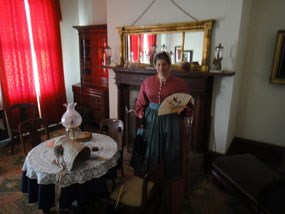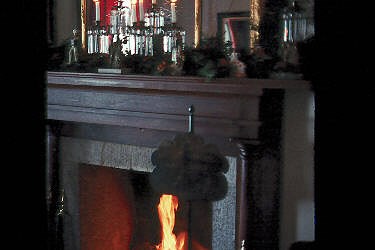
The first challenge that officers and their wives had to deal with was getting to their new homes. There were no railroads or stage lines on the frontier at this time. One had to travel by keelboat, riverboat, or overland in springless army wagons. It was slow, tiring, and extremely uncomfortable. The officers' first priority upon arriving at the new post would be to obtain quarters for their families. The quality of quarters varied from post to post, depending on the availability of construction materials, the skill of the builders, the age of the post, and of course, the allotted budget. In the early 1830s, an officer's family could expect to set up housekeeping in a one-room cabin with a dirt, or if they were lucky, a wooden floor. Walls were made of rough, unhewn logs, with and without chinking. Roofs were sometimes nothing more than a framework of boards with a sheet of canvas stretched over the top. Small sheet or cast iron stoves were used for cooking and warmth, and toilet facilities were usually in outhouses behind the quarters. Since transportation costs were high, the officer's family made do with only a few items of furniture. Packing crates were lined with calico to become cupboards for the few pieces of china, glass, and silver. Boards laid on sawhorses became an elegant table when topped by starched linen tablecloth. An oriental carpet might cover the damp floor and chintz curtains offered some privacy. Camp cots became comfortable when piled high with quilts and army blankets, and an easy chair could be made out of a barrel stuffed with moss and covered with calico. The quarters an officer's famly found when they arrived at a post might be as simple as a log shelter or as comfortable as Officers' Quarters No. 1 at Fort Scott. Whatever their lot they accepted it with equanimity and the officer's wife, if he were married, busied herself making a "home" out of her quarters, using the limited furniture and contents of the trunks and packing boxes that had accompanied her in the transport wagon. In a letter to a fellow officer of the First Dragoons, Captain Thomas Swords relayed that when he notified his wife, Charlotte, that she would be moving from Fort Leavenworth to Fort Gibson, she "takes it all in good part, only regrets leaving our little garden and other little comforts to which she has become attached there." As it turned out, Charlotte Swords joined her husband at Fort Scott instead. She must have been relieved because even the temporary quarters there were better than the old cabins built in 1824 at Fort Gibson. 
Fortunately for Charlotte, her husband, in his capacity as post quartermaster, was supervising the erection of permanent quarters at Fort Scott. Built in the French colonial style with Greek revival elements, they were of frame construction, had basements, high ceilings, walnut woodwork, plastered walls, fireplaces, and large porches, which ran across the front and back of the house. Swords said that he was building at Fort Scott what he considered to be "the Crack Post of the Frontier." Hence the officer's quarters here would be fairly elaborate. The officers' wives had to endure frequent moves and the high cost of transporting their personal effects. Captain Swords also mentioned preparations to "break up and sell out" items of furniture. By this time, it was customary for a departing officer to sell all or part of his goods to another officer to defray transportation costs. In 1843, a dragoon officer noted that "the direct consequence of making oneself comfortable appears to be to get orders for some other station." The frequent transfer from post to post caused another irritant for army wives. The practice of "ranking out" or "the bricks falling" was widespread and very disturbing. Upon arrival at a post, an officer could select the quarters of any subordinate officer. This often caused the whole garrison to move, because the displaced officer then had to chose from the remaining quarters. This usually resulted in the displacement of the lowest ranking officer and his family or caused them to double up on quarters with another family. It was particularly annoying when a bachelor officer displaced a family, or when gardens, polished floors, freshly calcimined walls, and a well stocked cellar had to be vacated. At Fort Scott, however, there was sufficient housing for the officers so that the practice of "ranking out" did not occur. Information for this section came from Sabers and Soapsuds: Dragoon Women on the Frontier by Dana Prater (used by permission) and the Historic Furnishings Report: Officers' Quarters by Sally Johnson Ketcham |
Last updated: July 25, 2016

